Analysis of Spatial Layout Influencing Factors in National Forest Tourism Villages: A Case Study of Liaoning Province
Abstract
1. Introduction
1.1. Literature Review
1.2. Research Aim and Hypotheses
2. Materials and Methods
2.1. Study Area
2.2. Data Source and Processing
2.3. Research Methods
2.3.1. Nearest Proximity Index
2.3.2. Geographical Concentration Index
2.3.3. Imbalance Index
2.3.4. Kernel Density Estimation
2.3.5. Geographic Detector (Geodetector)
3. Overall Distribution and Characteristics of National Forest Villages in Liaoning Province
3.1. Distribution Type Results
3.2. Equilibrium of the Spatial Distribution
3.3. Kernel Density Analysis
4. Influencing Factors of the Spatial Distribution of Forest Villages in Liaoning Province
4.1. Selection of Influencing Factors
4.1.1. Natural Influencing Factors
4.1.2. Socio-Economic Factors
4.1.3. Forest and Rural Tourism Endowment
4.2. Analysis of Influencing Factors
4.3. Factor Interaction Analysis
5. Discussion and Conclusions
5.1. Discussion
5.2. Research Limitations
5.3. Future Research
5.4. Conclusions
Author Contributions
Funding
Data Availability Statement
Conflicts of Interest
References
- Jin, Y.; Du, X.; Zhao, G.; Zhu, Z. Forest Village Construction in China: Practices and Development Strategy. Lin Cao Zhengce Yanjiu 2024, 4, 43–49. Available online: https://kns.cnki.net/kcms2/article/abstract?v=2Z_8GvOTliXEh29YB0ditwjxL_dwLssJHRVgAoKFd5GEmCFWBWUQolO3l93t6gL6PKJaHk9a6PL4YS7cxXcYsaupLiuuvm7ssOpnu-vv3nXtV7sVsG-WFwwyY4Jij6nuVYu044MZIk10_KIPYOgMCudI_YsYmUihdmCrGwV34sYaFJzZLxeFv3eDU-zCgaNBMj9tp_uLW7c=&uniplatform=NZKPT (accessed on 5 December 2024).
- National Forestry and Grassland Administration. Notice on the Evaluation and Certification of National Forest Villages (Document No. Lin Shengfa [2019] 77); National Forestry and Grassland Administration: Beijing, China, 2019. (In Chinese) [Google Scholar]
- Guo, Z. Research on the Coordinated Promotion of New Urbanization and Rural Revitalization Strategy. Decis. Explor. 2020, 4, 10–12. (In Chinese) [Google Scholar] [CrossRef]
- Zheng, Q.; Tian, T.; Yang, X. The Spatial Distribution and Influencing Factors of the National Forest Villages in China. J. Chin. Ecotourism 2021, 11, 441–454. [Google Scholar] [CrossRef]
- Ahn, D.; Kang, S.; Jeong, N. Plans for Turning the Culture and History of Rural Village Forest Landscape into a Tourism Resource. J. Recreat. Landsc. 2016, 10, 61–71. [Google Scholar]
- Senetra, A. Forests as an Important Spatial Element in Elaboration of the Esthetic Value Maps for Rural Landscapes. Sylwan 2015, 159, 757–766. [Google Scholar]
- Hoffmann, E.M.; Schareika, N.; Dittrich, C.; Schlecht, E.; Sauer, D.; Buerkert, A. Rurbanity: A concept for the interdisciplinary study of rural–urban transformation. Sustain. Sci. 2023, 18, 1739–1753. [Google Scholar] [CrossRef]
- Bren d’Amour, C.; Reitsma, F.; Baiocchi, G.; Barthel, S.; Güneralp, B.; Erb, K.-H.; Haberl, H.; Creutzig, F.; Seto, K.C. Future urban land expansion and implications for global croplands. Proc. Natl. Acad. Sci. USA 2017, 114, 8939–8944. [Google Scholar] [CrossRef]
- Angel, S.; Lamson-Hall, P.; Blei, A.; Shingade, S.; Kumar, S. Densify and Expand, a Global Analysis of Recent Urban Growth. Sustainability 2021, 13, 3835. [Google Scholar] [CrossRef]
- Marconcini, M.; Metz-Marconcini, A.; Esch, T.; Gorelick, N. Understanding Current Trends in Global Urbanisation—The World Settlement Footprint Suite. GI_Forum 2021, 12, 33–38. [Google Scholar] [CrossRef]
- van Vliet, J.; Birch-Thomsen, T.; Gallardo, M.; Hemerijckx, L.M.; Hersperger, A.M.; Li, M.; Tumwesigye, S.; Twongyirwe, R.; van Rompaey, A. Bridging the Rural–Urban Dichotomy in Land Use Science. J. Land Use Sci. 2020, 15, 585–591. [Google Scholar] [CrossRef]
- Ríos-Llamas, C.; Hernández-Vázquez, S. Counterurbanization in the peri-urban forest of Guadalajara, México. Rev. Econ. e Sociol. Rural 2024, 62, e275967. [Google Scholar] [CrossRef]
- Ordónez, C.; Duinker, P.N. Urban forest values of the citizenry in three Colombian cities. Soc. Nat. Resour. 2014, 27, 834–849. [Google Scholar] [CrossRef]
- Steenberg, J.W.; Robinson, P.J.; Duinker, P.N. A spatio-temporal analysis of the relationship between housing renovation, socioeconomic status, and urban forest ecosystems. Environ. Plan. B Urban Anal. City Sci. 2019, 46, 1115–1131. [Google Scholar] [CrossRef]
- Romanelli, J.P.; Piana, M.R.; Klaus, V.H.; Brancalion, P.H.; Murcia, C.; Cardou, F.; Wallace, K.J.; Adams, C.; Martin, P.A.; Burton, P.J. Convergence and divergence in science and practice of urban and rural forest restoration. Biol. Rev. 2024, 99, 295–312. [Google Scholar] [CrossRef]
- Bamert, M.; Ströbele, M.; Buchecker, M. Ramshackle farmhouses, useless old stables, or irreplaceable cultural heritage? Local inhabitants’ perspectives on future uses of the Walser built heritage. Land Use Policy 2016, 55, 121–129. [Google Scholar] [CrossRef]
- Omidvar, M. (Ed.) Designing a strategic planning model for government organizations and implementing at the Iranian Information and Documentation Center, Shiraz University, Tarbiat Modarres University and Tehran Municipal Cultural and Artistic Organization. Workshop Report. 2004. (In Persian) [Google Scholar]
- Roknoddin Eftekhari, A.; Mahdavi, D.; Akbari Samani, N. Providing strategic planning pattern for sustainable rural tourism development. Hum. Geogr. Res. 2011, 1, 123–146. [Google Scholar]
- Husnaini, A. The Effect of the Existence of Pagsan Tourism Village on Changes in Land Use, Economic, and Social Communities. Int. J. Sustain. Competit. Tour. 2023, 2, 96–103. [Google Scholar] [CrossRef]
- Nouri, H.; Rastghalam, M.; Amini, S. Assessment of tolerable capacity in the tourist destination of villages. J. Geogr. Environ. Stud. 2024, 5, 20–39. [Google Scholar]
- Amru, K.; Fahmi, S.; Ningrum, M.H.; Laksmita, A.N.; Jati, E.D. Identification of Environmental Issues on the Ecoregion of Volcanic and Fluvio-Volcanic Landform in Badung Regency. J. Sylva Lestari 2022, 10, 333–344. [Google Scholar] [CrossRef]
- Skog, K.L.; Steinnes, M. How do centrality, population growth and urban sprawl impact farmland conversion in Norway? Land Use Policy 2016, 59, 185–196. [Google Scholar] [CrossRef]
- Carroll, P.; Benevenuto, R.; Caulfield, B. Identifying hotspots of transport disadvantage and car dependency in rural Ireland. Transp. Policy 2021, 101, 46–56. [Google Scholar] [CrossRef]
- Reshadat, S.; Zangeneh, A.; Saeidi, S.; Teimouri, R.; Yigitcanlar, T. Measures of spatial accessibility to health centers: Investigating urban and rural disparities in Kermanshah, Iran. J. Public Health 2019, 27, 519–529. [Google Scholar] [CrossRef]
- Kim, G.; Kang, W.; Park, C.R.; Lee, D. Factors of spatial distribution of Korean village groves and relevance to landscape conservation. Landsc. Urban Plan. 2018, 176, 30–37. [Google Scholar] [CrossRef]
- Meng, Y.; Cao, B.; Dong, C.; Dong, X. Mount Taishan forest ecosystem health assessment based on forest inventory data. Forests 2019, 10, 657. [Google Scholar] [CrossRef]
- Kearney, S.P.; Coops, N.C.; Sethi, S.; Stenhouse, G.B. Maintaining accurate, current, rural road network data: An extraction and updating routine using RapidEye, participatory GIS and deep learning. Int. J. Appl. Earth Obs. Geoinf. 2020, 87, 102031. [Google Scholar] [CrossRef]
- Wijana, N.; Citrawathi, D.M.; Mulyadiharja, S.; Julyasih, K.S.M.; Dewi, N.P.S.R. Results of Ethnoecological Studies in the Prospect of Forest Tourism Development in Tenganan Pegringsingan Traditional Village, Karangasem, Bali. Balt. For. 2022, 28, BF599. [Google Scholar] [CrossRef]
- Meng, K.; Tang, J.; Wang, M.; Zhang, B.; Yuan, H. Analysis and Empirical Study on the Influencing Factors of Residents’ Support at the Exploration Stage of Tourism Development: A Case Study of Beigang Village in Haikou City. Trop. Geogr. 2023, 1, 1–12. [Google Scholar]
- Cai, X.M.; Liu, M.X.; Lin, J.H.; Ma, G.Q. Dynamic representation and formation mechanism of rural gentrification in the context of tourism development: A case study of Shangliang village, Huizhou, Guangdong. Tour. Trib. 2021, 36, 55–68. [Google Scholar]
- Zhu, W.C.; Peng, J.; Cheng, Q.P.; Chen, P.Y.; Zhang, R.R. Land Use Changes and Spatial Evolution of Tourism Villages: Taking Two Villages of Chuzhou City as Examples. Anhui Agric. Sci. Bull. 2017, 23, 1–4. [Google Scholar]
- Huang, X.; Bai, O. Spatial distribution characteristics and influencing factors of forest villages in Zhejiang Province. J. Zhejiang A&F Univ. 2022, 39, 884–893. [Google Scholar]
- Wang, Z.; Zhu, J.; Wu, Z. Study on the Spatial Distribution Characteristics of Traditional Villages and Their Response to the Water Network System in the Lower Yangtze River Basin. Sci. Rep. 2024, 14, 22586. [Google Scholar] [CrossRef]
- Kong, X.S.; Fu, M.X.; Jiang, P. The spatial pattern of rural areas with Chinese characteristics and the coordination of tourism space are optimized. Acta Geo Graph. Sin. 2023, 78, 2554–2573. [Google Scholar]
- Luo, R.J.; Chen, X.; Xiong, L.R. Spatial distribution pattern of national forest and rural areas in Yunnan Province and its causes. J. China Agric. Resour. Reg. Plan. 2023, 44, 146–158. [Google Scholar]
- Wu, C.; Chen, M.; Zhou, L.; Liang, X.; Wang, W. Identifying the spatiotemporal patterns of traditional villages in China: A multiscale perspective. Land 2020, 9, 449. [Google Scholar] [CrossRef]
- Wei, D.; Wang, Z.; Zhang, B. Traditional village landscape integration based on social network analysis: A case study of the yuan river basin in south-western China. Sustainability 2021, 13, 13319. [Google Scholar] [CrossRef]
- Li, T.; Li, C.; Zhang, R.; Cong, Z.; Mao, Y. Spatial heterogeneity and influence factors of traditional villages in the Wuling Mountain area, Hunan Province, China based on Multiscale Geographically Weighted Regression. Buildings 2023, 13, 294. [Google Scholar] [CrossRef]
- Su, H.; Wang, Y.; Zhang, Z.; Dong, W. Characteristics and Influencing Factors of Traditional Village Distribution in China. Land 2022, 11, 1631. [Google Scholar] [CrossRef]
- Chen, W.; Yang, L.; Wu, J.; Wu, J.; Wang, G.; Bian, J.; Zeng, J.; Liu, Z. Spatio-temporal characteristics and influencing factors of traditional villages in the Yangtze River Basin: A Geodetector model. Herit. Sci. 2023, 11, 111. [Google Scholar] [CrossRef]
- Wang, L.X.; Jiang, Q.O.; Qi, Y.J.; Zhang, B.L. Study on dual evaluation and zoning of land spatial planning in rural areas around metropolis: Taking Changping, Beijing as study case. J. China Agric. Univ. 2024, 29, 167–185. [Google Scholar]
- Chen, W.; Yang, Z.; Yang, L.; Wu, J.; Bian, J.; Zeng, J.; Liu, Z. Identifying the Spatial Differentiation Factors of Traditional Villages in China. Herit. Sci. 2023, 11, 5. [Google Scholar] [CrossRef]
- Chen, L.; Zhong, Q.; Li, Z. Analysis of Spatial Characteristics and Influence Mechanism of Human Settlement Suitability in Traditional Villages Based on Multi-Scale Geographically Weighted Regression Model: A Case Study of Hunan Province. Ecol. Indic. 2023, 154, 110828. [Google Scholar] [CrossRef]
- Liu, W.X.; Xue, Y.; Shang, C. Spatial Distribution Analysis and Driving Factors of Traditional Villages in Henan Province: A Comprehensive Approach via Geospatial Techniques and Statistical Models. Herit. Sci. 2023, 11, 185. [Google Scholar] [CrossRef]
- Wu, B.; Xiao, J. Research on spatial distribution and correlation of the historical and cultural towns(villages) in China. Econ. Geogr. 2012, 32, 6–11. [Google Scholar]
- Zhang, H.; Lu, L.; Zhang, D.; Yu, H.; Zhang, X. Spatial pattern and contributing factors of homestay inns in the area around Mogan Mountain. Geogr. Res. 2019, 38, 2695–2715. [Google Scholar]
- Chen, P.; Yang, X.; Du, M. A study on the spatial distribution of China national eco-tourism demonstration area. Ecol. Econ. 2018, 34, 132–136. [Google Scholar]
- Lu, X.; Kuang, B.; Li, J. Regional difference decomposition and policy implications of China’s urban land use efficiency under the environmental restriction. Habitat Int. 2018, 77, 32–39. [Google Scholar] [CrossRef]
- Guan, Z.; Wang, T.; Zhi, X. Temporal-spatial pattern differentiation of traditional villages in central plains economic region. Econ. Geogr. 2017, 37, 225–232. [Google Scholar]
- Wang, J.-F.; Zhang, T.-L.; Fu, B.-J. A measure of spatial stratified heterogeneity. Ecol. Indic. 2016, 67, 250–256. [Google Scholar] [CrossRef]
- Zhou, Y.; Huang, H.; Liu, Y. The spatial distribution characteristics and fluencing factors of Chinese villages. Acta Geo Graph. Sin. 2020, 75, 2206–2223. [Google Scholar]
- Wang, W.; Liu, Y.J.; Chen, G. Spatial Distribution Characteristics and Its Influencing Factors of Traditional Villages in the Yangtze River Delta Region. Ind. Constr. 2023, 53, 1–15. [Google Scholar]
- Chen, S.; Yu, X. Spatial Distribution Characteristics and Influencing Factors of Key Rural Tourism Villages in the Chengdu–Chongqing Twin-City Economic Circle. J. Chongqing Norm. Univ. (Nat. Sci. Ed.) 2023, 40, 81–94. [Google Scholar]
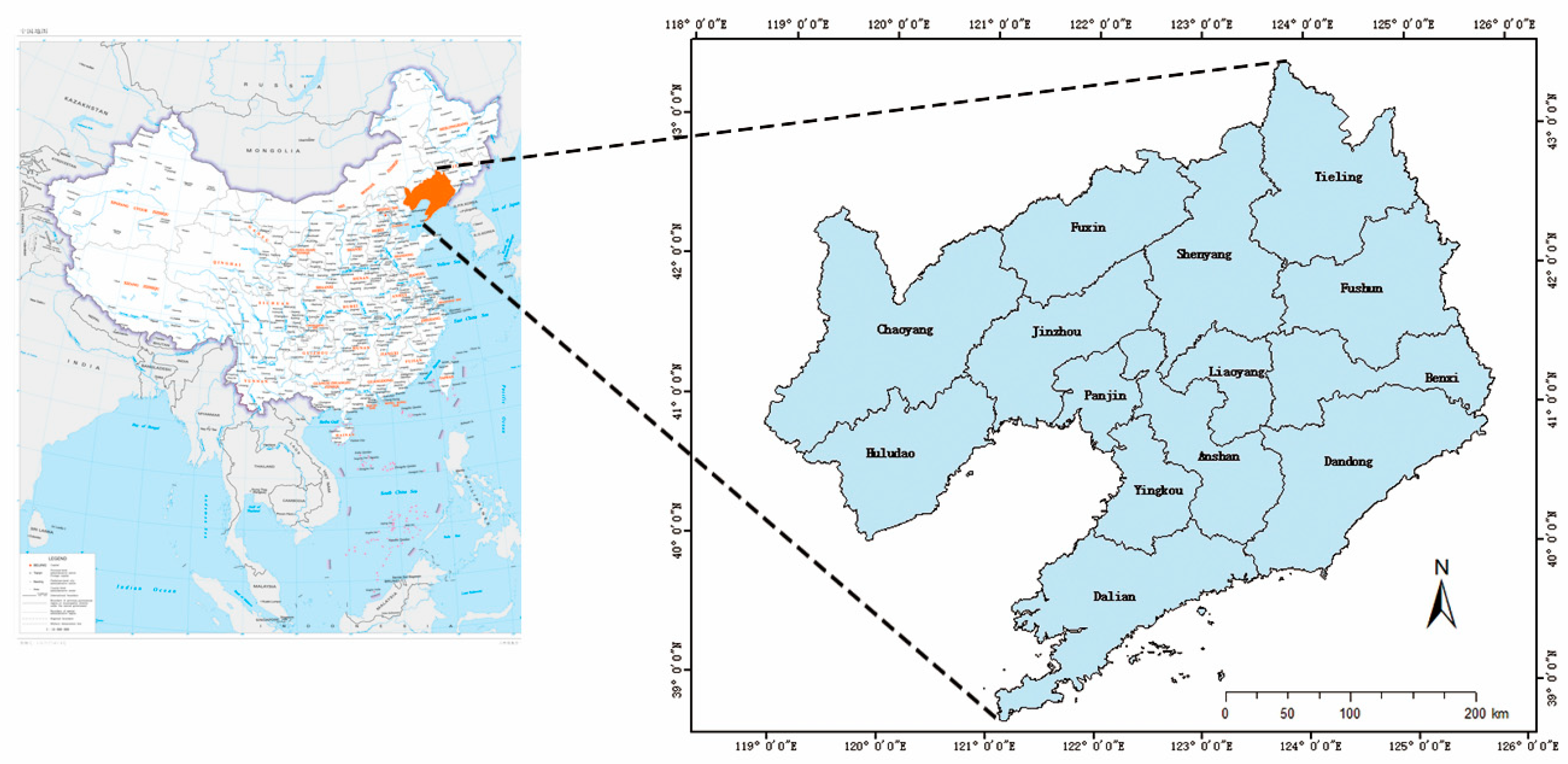
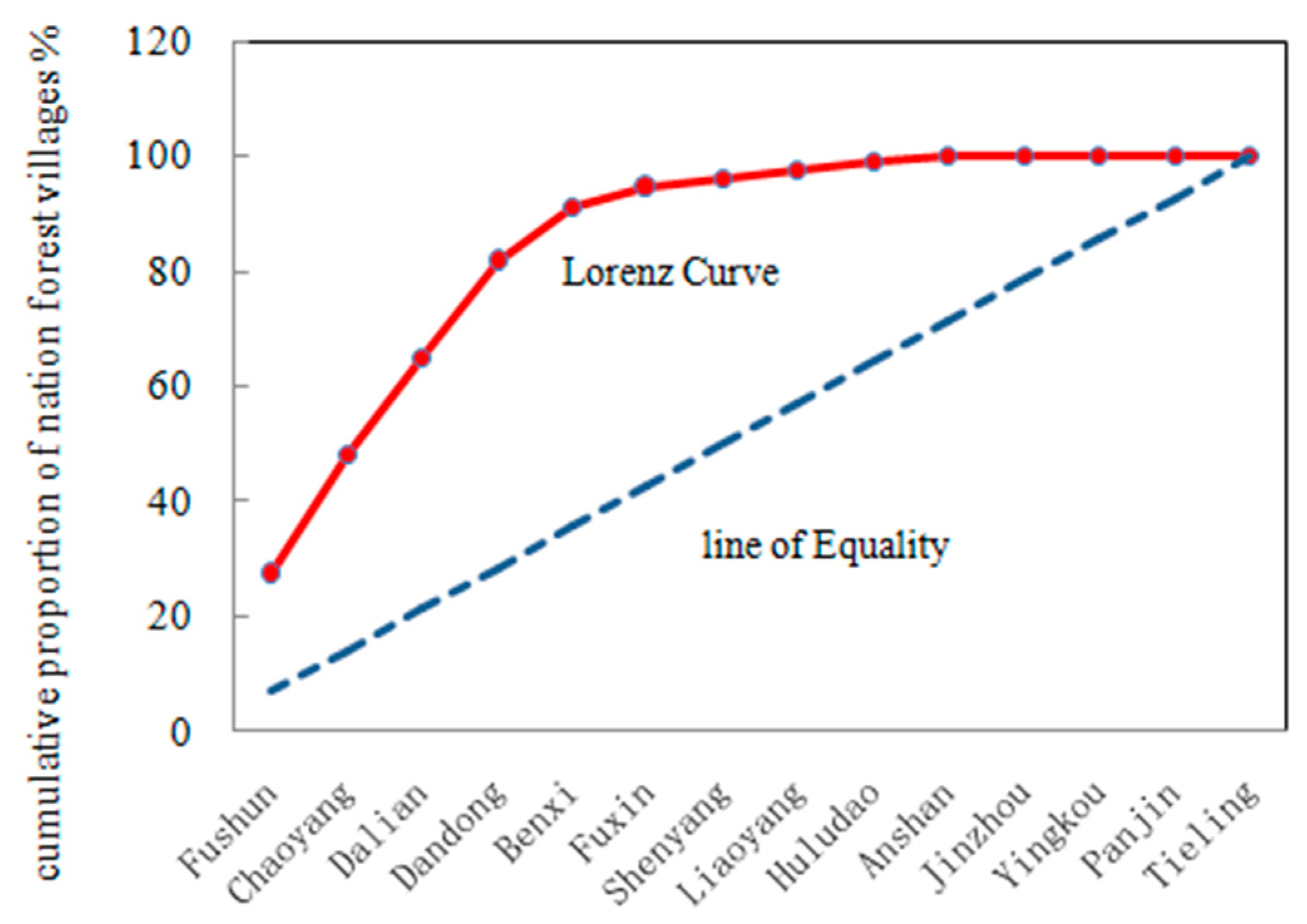
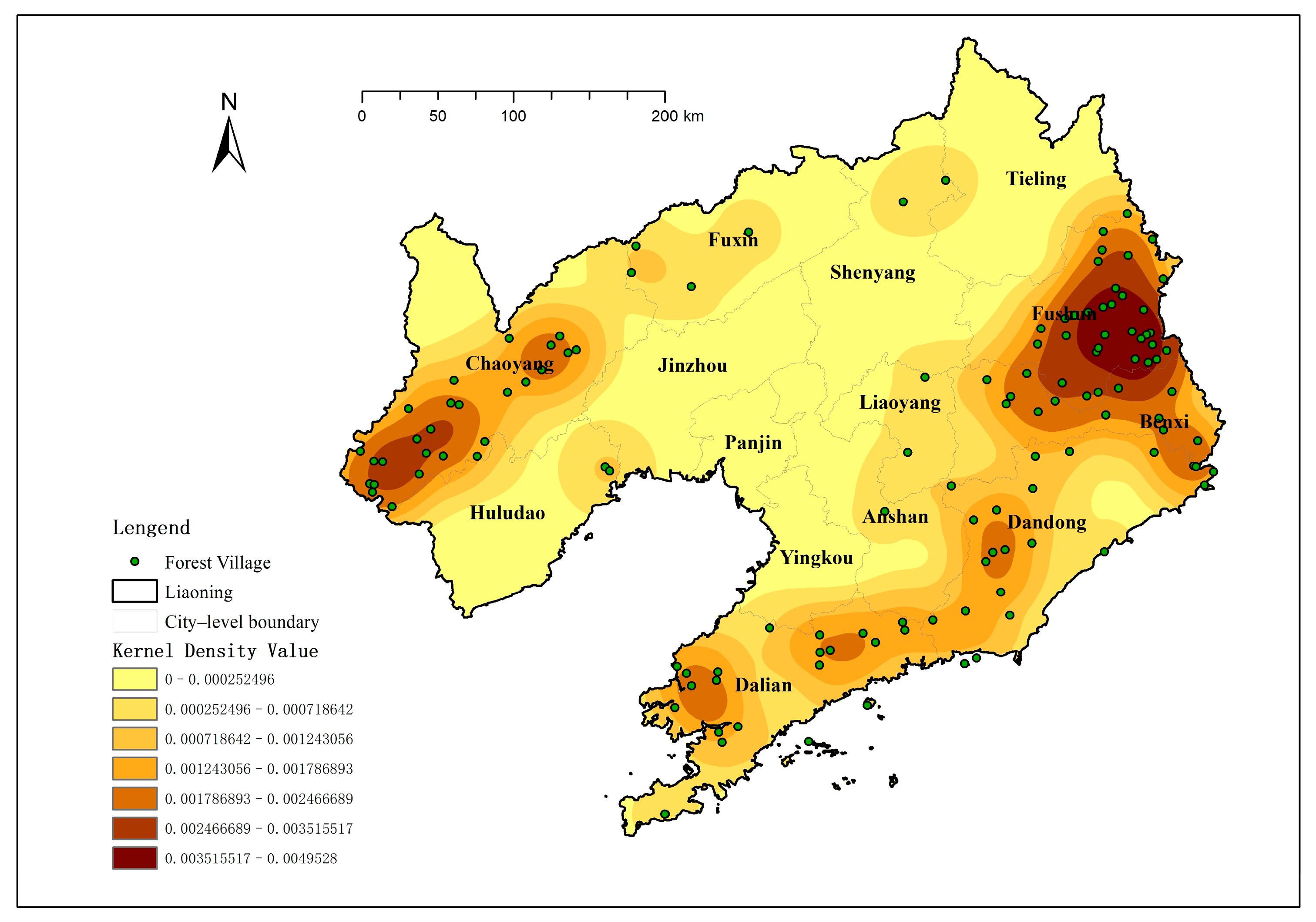

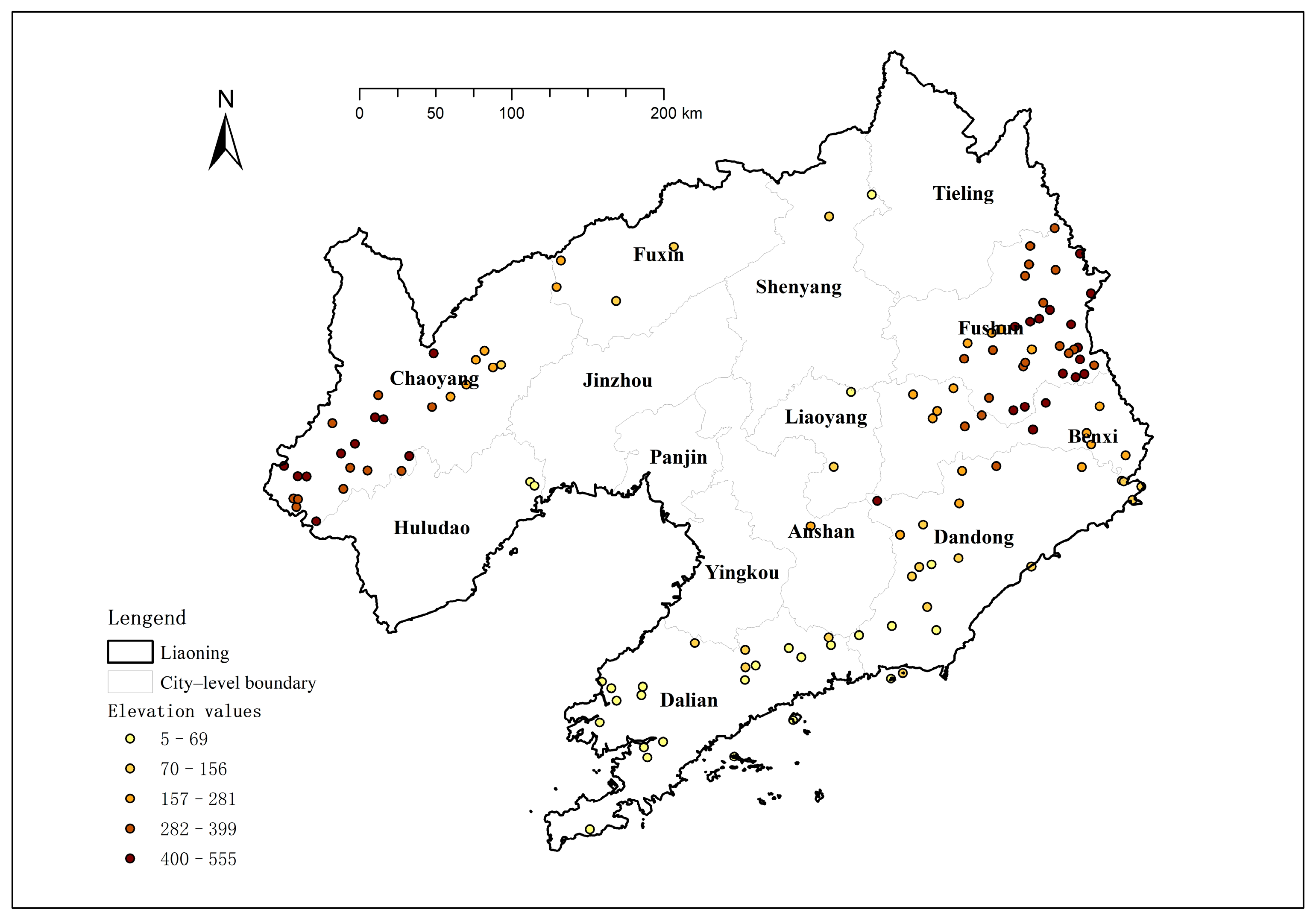
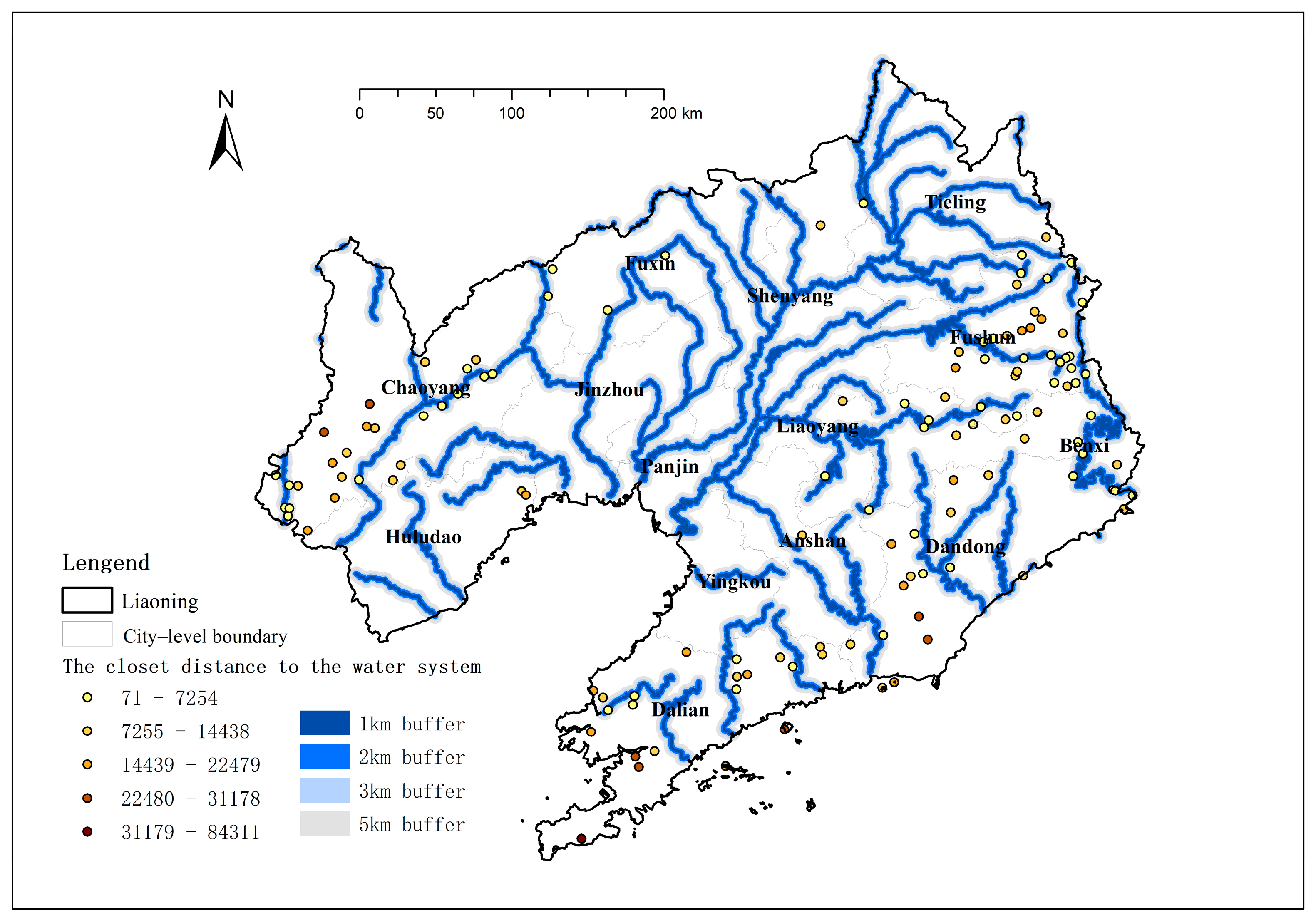

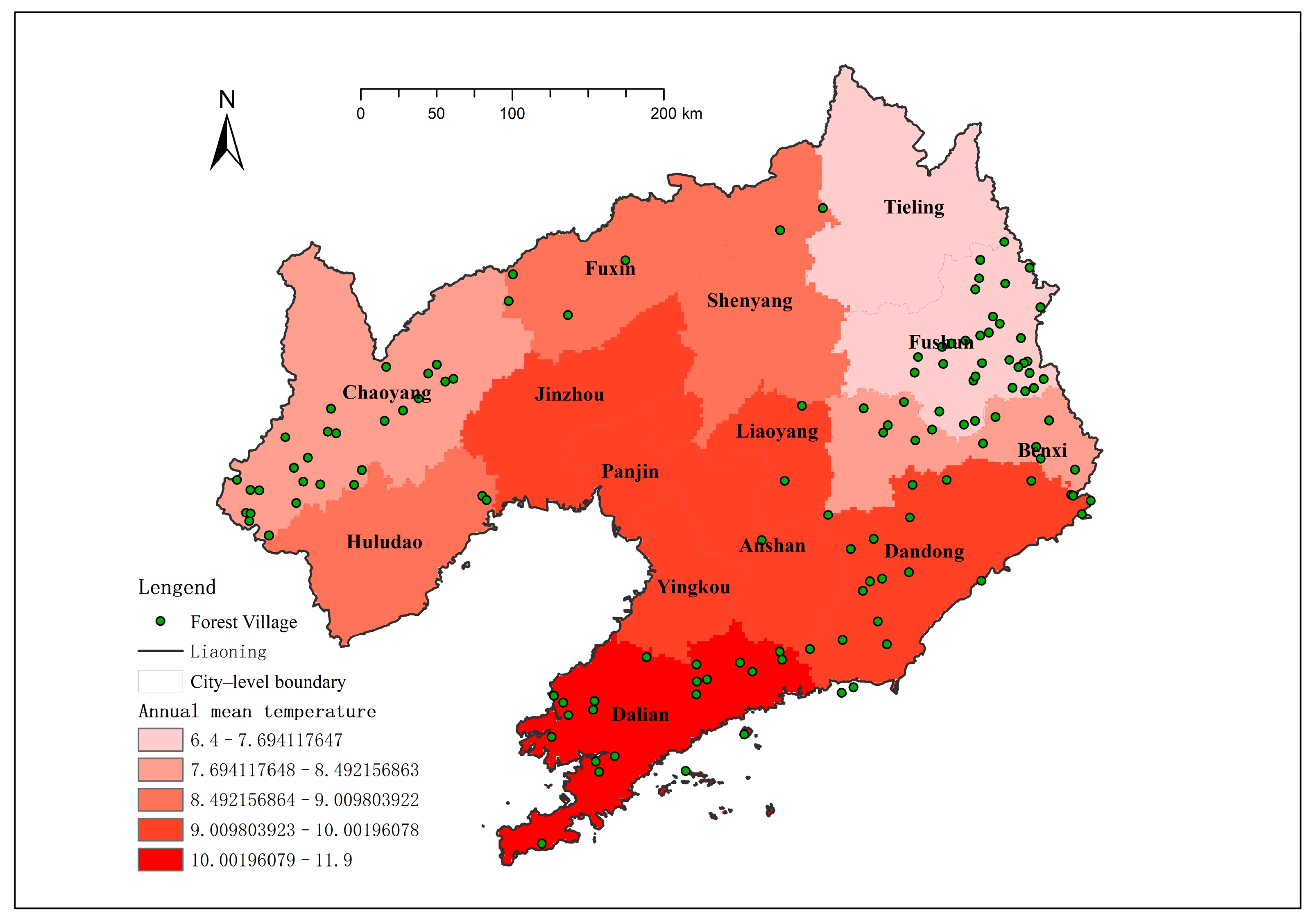
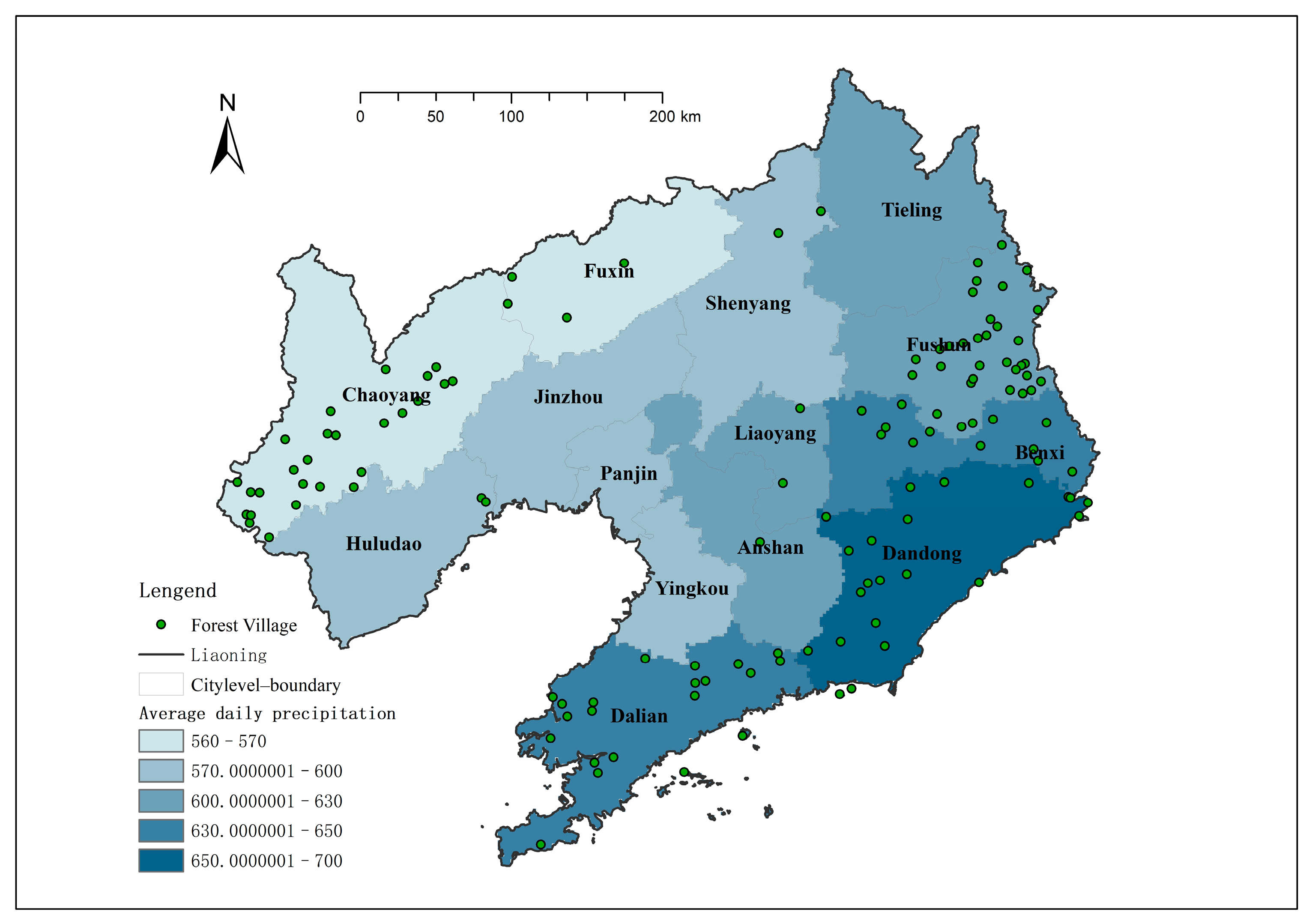
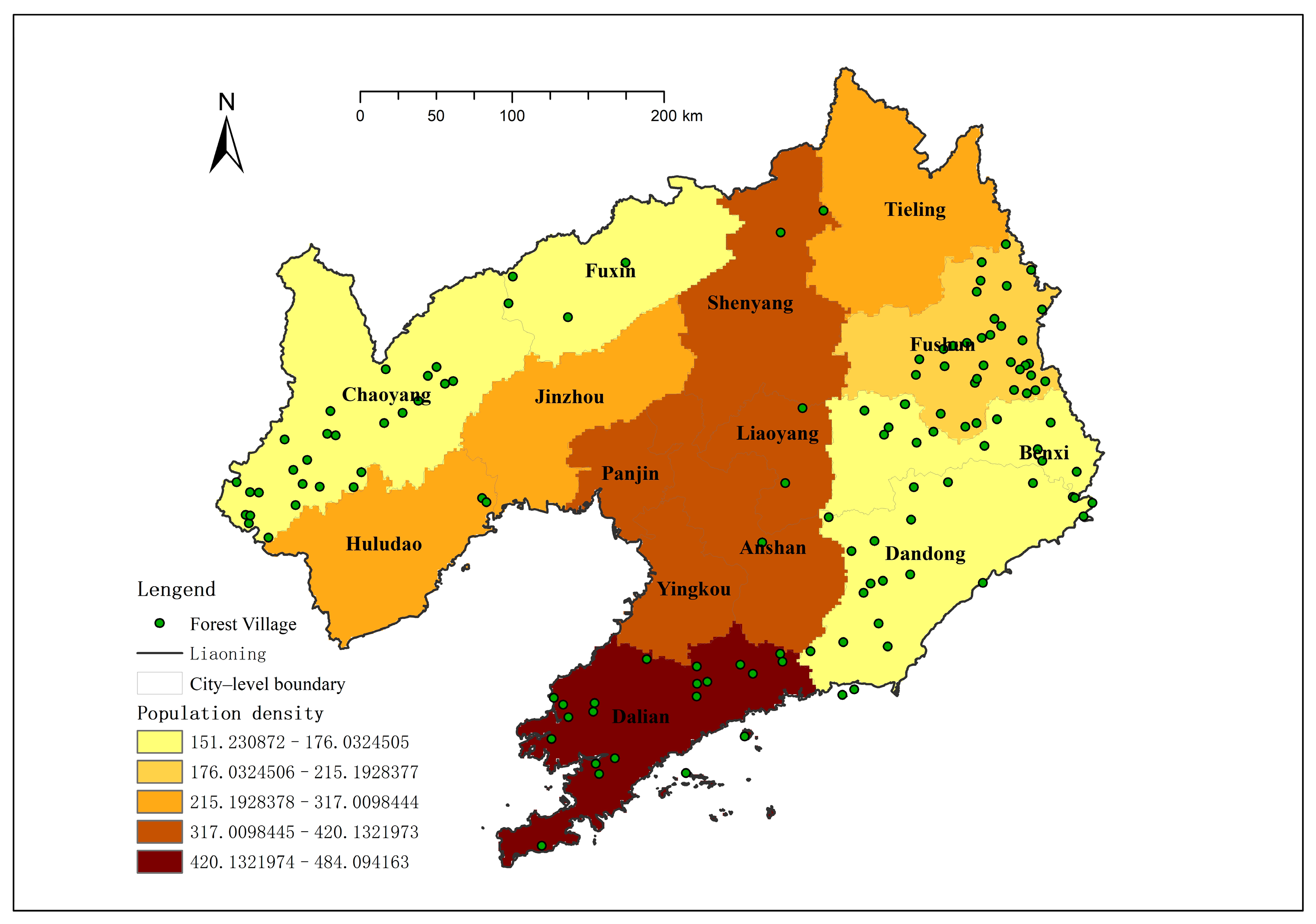
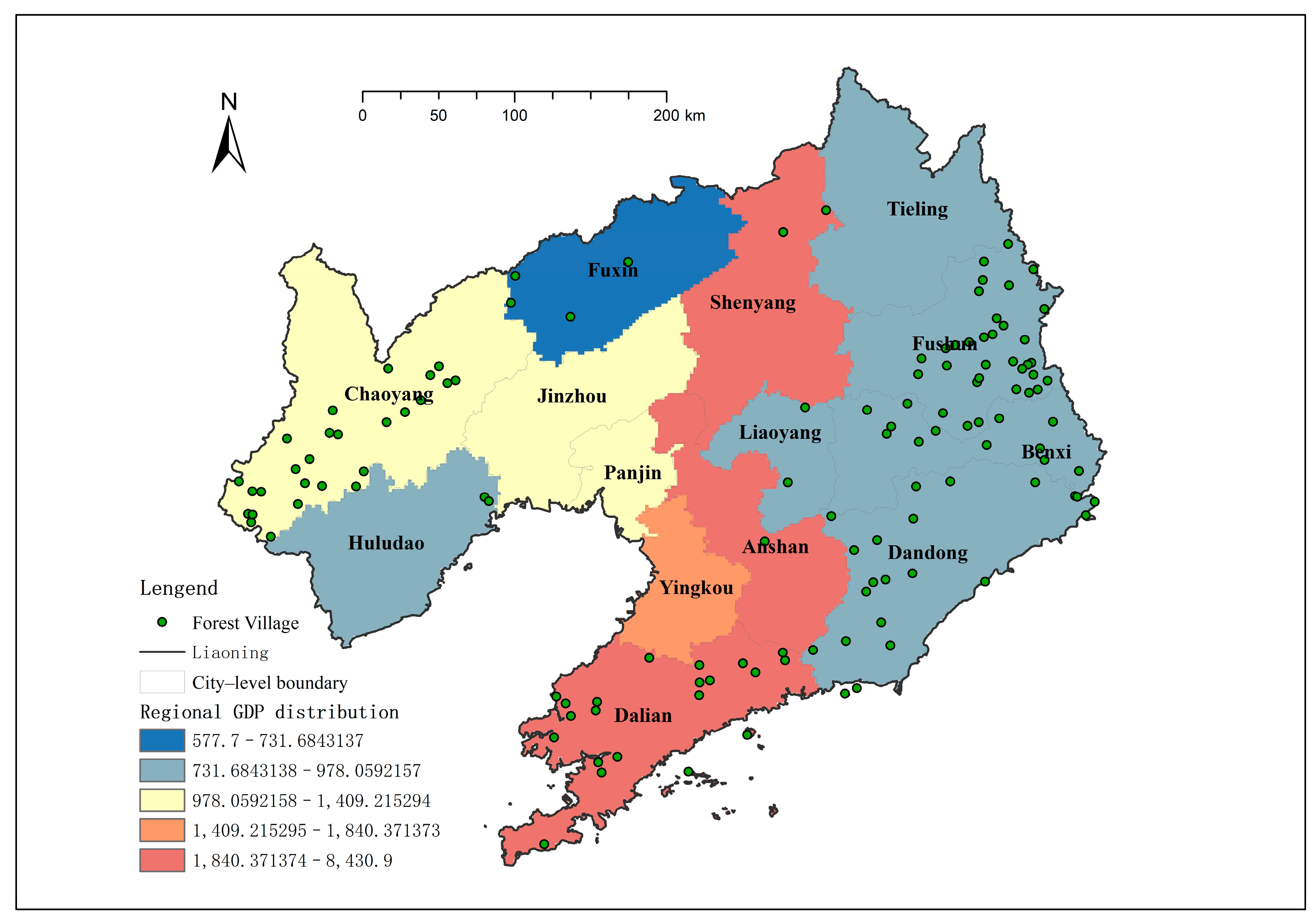
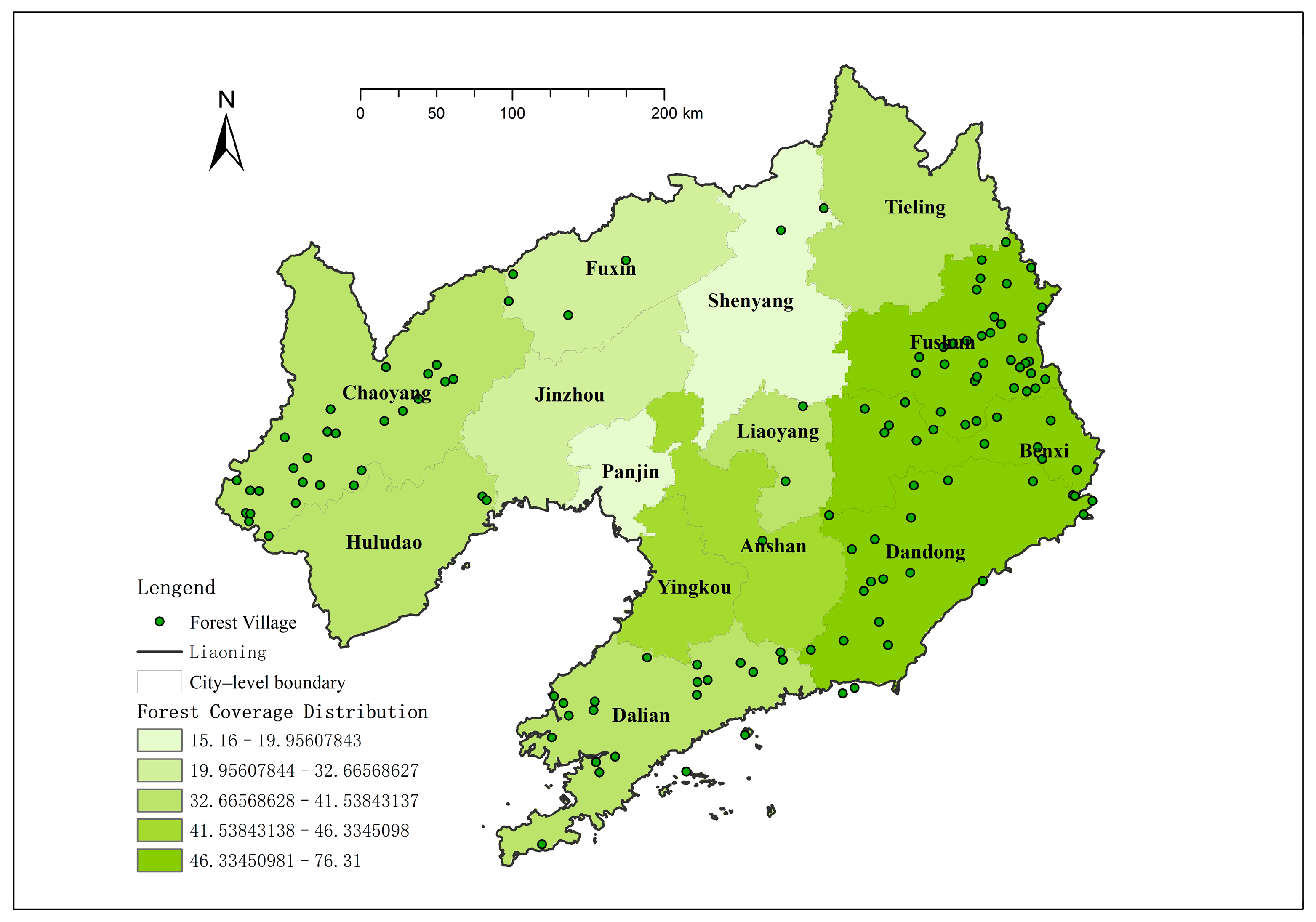
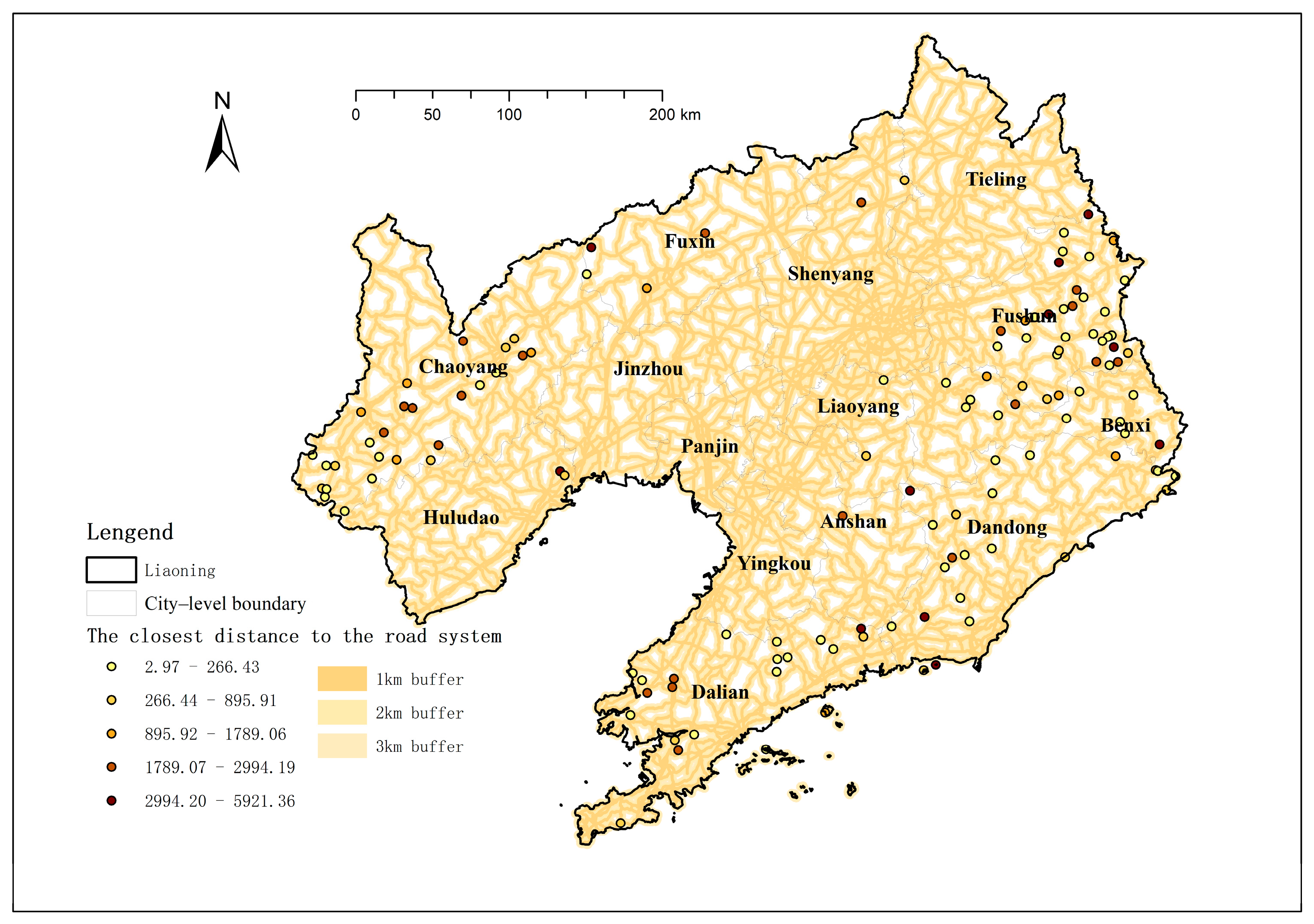

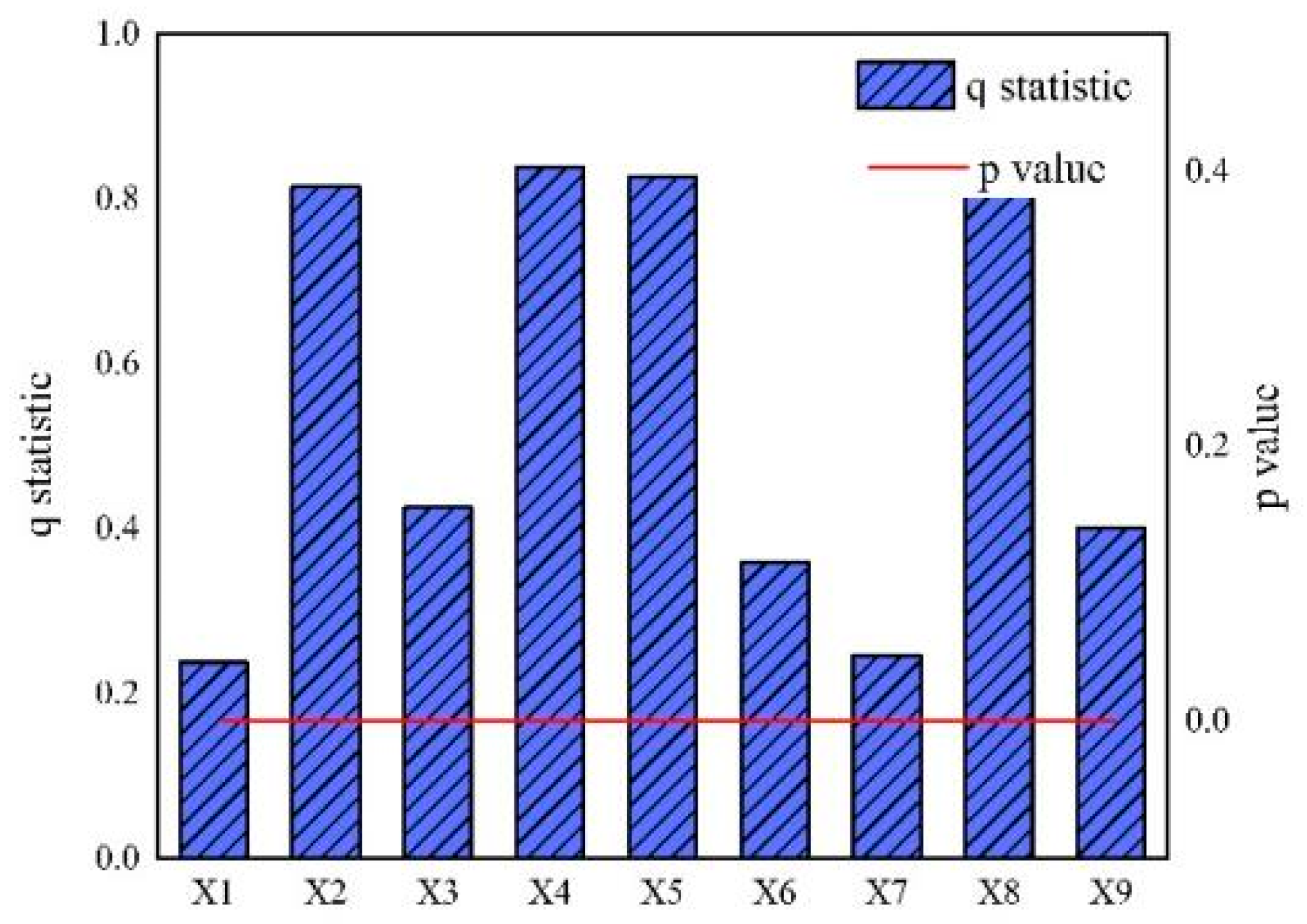
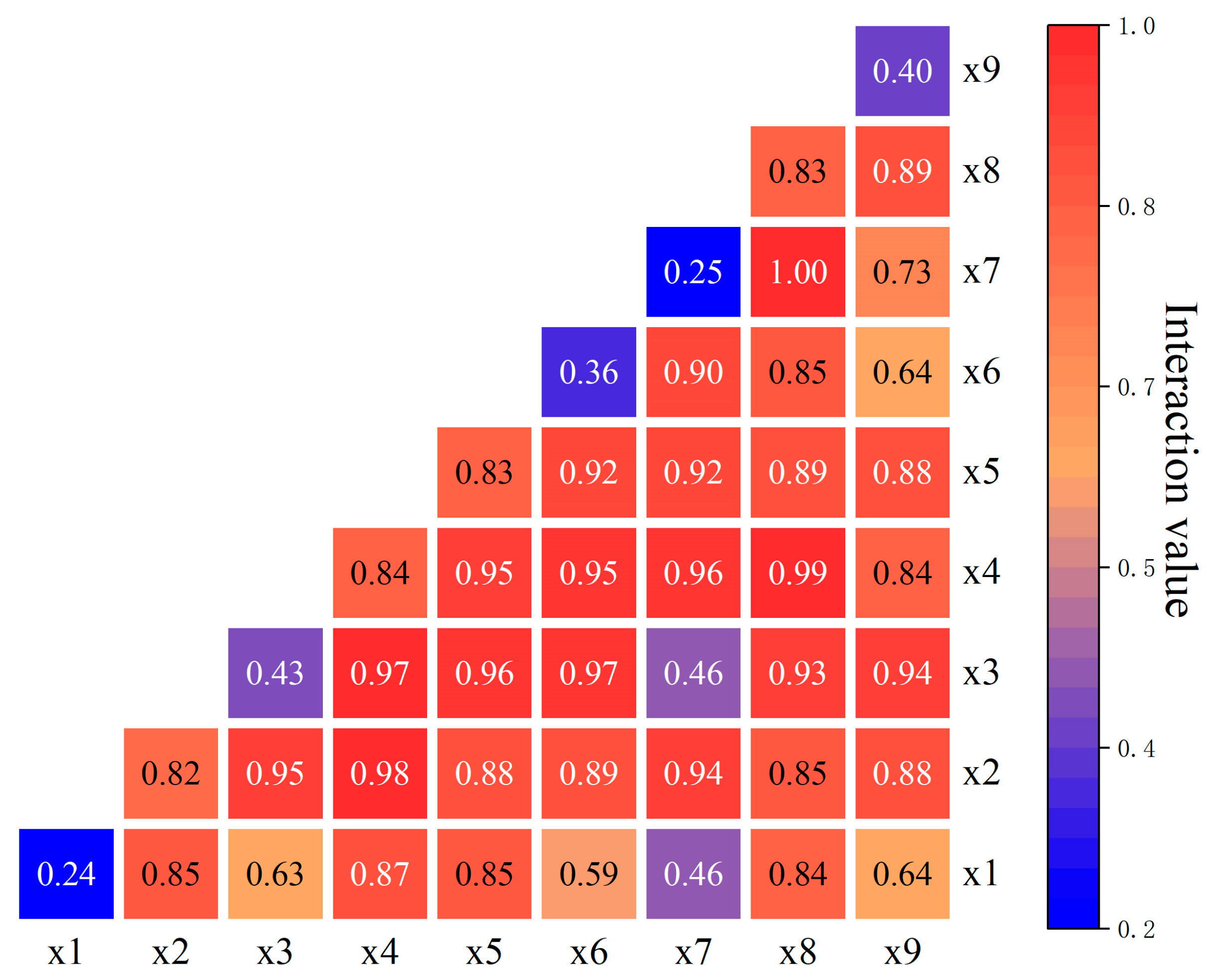
| No. | City Name | Number |
|---|---|---|
| 1 | Shenyang | 2 |
| 2 | Dalian | 21 |
| 3 | Anshan | 1 |
| 4 | Fushun | 34 |
| 5 | Benxi | 12 |
| 6 | Dandong | 21 |
| 7 | Jinzhou | 0 |
| 8 | Yingkou | 0 |
| 9 | Fuxin | 4 |
| 10 | Liaoyang | 2 |
| 11 | Panjin | 0 |
| 12 | Tieling | 0 |
| 13 | Chaoyang | 26 |
| 14 | Huludao | 2 |
| CITY | Number of Villages (Count) | Proportion (%) | Cumulative Proportion (%) | CITY | Number of Villages (Count) | Proportion (%) | Cumulative Proportion (%) |
|---|---|---|---|---|---|---|---|
| Fushun | 34 | 27.2 | 27.2 | Liaoyang | 2 | 1.6 | 97.6 |
| Chaoyang | 26 | 20.8 | 48 | Huludao | 2 | 1.6 | 99.2 |
| Dalian | 21 | 16.8 | 64.8 | Anshan | 1 | 0.8 | 100 |
| Dandong | 21 | 16.8 | 81.6 | Jinzhou | 0 | 0 | 100 |
| Benxi | 12 | 9.6 | 91.2 | Yingkou | 0 | 0 | 100 |
| Fuxin | 4 | 3.2 | 94.4 | Panjin | 0 | 0 | 100 |
| Shenyang | 2 | 1.6 | 96 | Tieling | 0 | 0 | 100 |
| Elevation Range (m) | Number of Villages (Count) | Proportion (%) |
|---|---|---|
| <100 | 33 | 26.4 |
| 100~200 | 25 | 20 |
| 200~300 | 23 | 18.4 |
| 300~400 | 23 | 18.4 |
| 400~500 | 15 | 12 |
| >500 | 4 | 3.2 |
Disclaimer/Publisher’s Note: The statements, opinions and data contained in all publications are solely those of the individual author(s) and contributor(s) and not of MDPI and/or the editor(s). MDPI and/or the editor(s) disclaim responsibility for any injury to people or property resulting from any ideas, methods, instructions or products referred to in the content. |
© 2025 by the authors. Licensee MDPI, Basel, Switzerland. This article is an open access article distributed under the terms and conditions of the Creative Commons Attribution (CC BY) license (https://creativecommons.org/licenses/by/4.0/).
Share and Cite
Qi, L.; Dong, J.; Yu, R. Analysis of Spatial Layout Influencing Factors in National Forest Tourism Villages: A Case Study of Liaoning Province. Land 2025, 14, 857. https://doi.org/10.3390/land14040857
Qi L, Dong J, Yu R. Analysis of Spatial Layout Influencing Factors in National Forest Tourism Villages: A Case Study of Liaoning Province. Land. 2025; 14(4):857. https://doi.org/10.3390/land14040857
Chicago/Turabian StyleQi, Lin, Jun Dong, and Rongrong Yu. 2025. "Analysis of Spatial Layout Influencing Factors in National Forest Tourism Villages: A Case Study of Liaoning Province" Land 14, no. 4: 857. https://doi.org/10.3390/land14040857
APA StyleQi, L., Dong, J., & Yu, R. (2025). Analysis of Spatial Layout Influencing Factors in National Forest Tourism Villages: A Case Study of Liaoning Province. Land, 14(4), 857. https://doi.org/10.3390/land14040857








